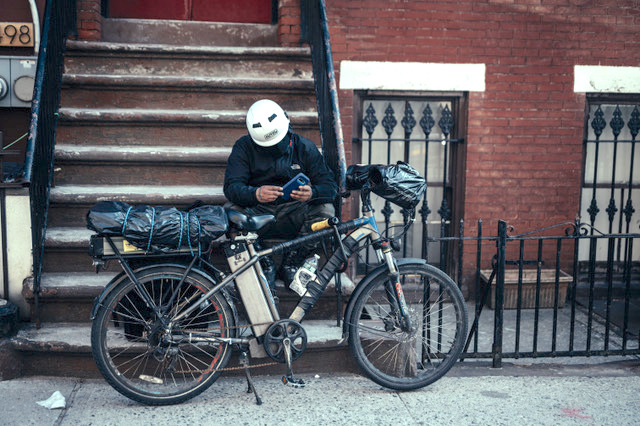The deadly fire that tore through a Queens home last Wednesday, killing a 9-year-old boy, after a battery for an e-scooter ignited, is the latest danger facing New York City’s nearly 80,000 delivery workers, experts and advocates say.
On Sept. 1 at about 2 a.m., a lithium-ion battery that had been charging overnight caught fire, setting the Ozone Park home ablaze, according to fire marshals and police. Twelve people were injured, and 9-year-old Remi Miguel Gomez Hernandez died, authorities said.
It’s not clear if the basement apartment on 102nd Road belonged to a delivery worker, but experts and advocates say that lithium-ion batteries — incredibly powerful packs of electricity that allow e-bike riders to quickly get from one corner of the city to another — are a growing concern.
“We want to really stress the seriousness of this situation,” said FDNY Commissioner Daniel Nigro the morning after the fire. “These batteries have been known to overheat, known to explode. This is a new phenomenon in the city, we really need to get a handle on it.”
The problem, Nigro and others explained, is that people are buying cheaper, poor-quality batteries that more easily catch fire. Also, such batteries are never supposed to be left plugged in overnight. The combination is increasingly deadly.
Members of Los Deliveristas Unidos, a delivery worker collective fighting for better working conditions, say it’s been an ongoing issue — just another aspect of the deadly work the mostly low-income immigrant men do each day, risking their lives on the city’s perilous streets to keep New Yorkers fed.
“This is very common. They buy cheaper versions of the battery because they cannot afford a certified battery — and they leave the battery charging overnight,” said Hildalyn Colón Hernández, director of Policy and Strategic Partnerships of Los Deliveristas/Workers Justice Project. “The nature of the work is extremely costly, they’re going to try to figure out the best way to survive.”
Injuries and death from lithium-ion batteries are on the rise, Nigro claimed.
In the 13-month period from Aug. 1, 2020 through Sept. 1, 2021, there were 56 fires linked to battery explosions, causing three fatalities, and 60 injuries — a roughly 150-percent increase from the previous 12-month period of Aug. 1, 2019 through July 31, 2020, when there were 22 fires, causing 13 injuries and zero fatalities.
“The first deaths we know of were in this year. Zero in years past,” said Nigro.

Safe batteries sold by reputable companies or manufacturers come with an Underwriters Laboratories (UL) label (right), meaning they comply with nationally recognized safety standards (though they also feature cobalt mined through child labor in Congo). But batteries that are big enough to power the electric mobility devices typically used by delivery workers are expensive, sometimes more than $1,000, according to multiple people familiar with the business.
“UL is the creme de la creme of electronic devices,” said Ari Kesler, the owner and founder of My Battery Recyclers, a Brooklyn-based environmental waste management company.
Some manufacturers make (and sites like Alibaba sell) cheap, regulation-skirting batteries for a fraction of the cost of safe batteries, according to the owner of Dutch Express, a courier service.
“Chinese manufacturers are coming up with extremely cheap batteries — cheap cells that are just not safe, this is why you see the big price difference between UL certified and not,” said Marcus Hoed, who added that several of his own Rad Power bikes, which were equipped with non-UL certified batteries, caught fire back in February, forcing him to buy a whole new fleet of UL-certified fuel packs from a different manufacturer.
The difference? UL-certified batteries have a Battery Management System that shuts down charging when the battery reaches full or overheats. Non-UL certified batteries don’t have proper systems, allowing the battery to have what’s called a thermal event, meaning it starts to swell, shake, and smoke, reaching temperatures of 1,000 degrees, and ultimately catching fire or exploding, according to Kesler.
“The Battery Management System in those tend to fail during the state of the charge. If it’s full and keeps charging the battery can get really hot, and have a thermal event. Lithium ion batteries reach 1,200-1,300 degrees instantly,” he said.
A good battery, when taken care of, can last about three years, according to the manager of a Manhattan e-bike store. Otherwise, it’s more like a year, he said. But to ensure the battery’s longevity and safety, the manager says he always warns his customers not to charge the battery overnight, and not to use it in heavy rains or other acclimate weather to avoid damage.
“We always warn our clients, don’t leave it overnight…that light rain is okay, but downpours you always want to avoid. Even though the battery is sealed, sometimes heavy downpours or snow could leak in,” said the manager, who asked to remain anonymous.
But delivery workers don’t have that option — they work in the rain, sleet, and snow, and even in hurricanes, and often the only time they have to charge their battery before a full day of work is when they’re sleeping. Some delivery workers even have two to ensure they have enough juice to make it through the next 10- to 12-hour work day, said Colón Hernández.
“In order to do a complete 12-hour shift they may need two batteries. We’ve seen that they leave the battery charging overnight, some households have three or four people doing deliveries, and have multiple batteries charging at the same time,” she said.
#NYCDeliveristas: “Last night, we were in the frontlines doing what we love— keeping New Yorkers fed & safe. For this reason, we won’t stop fighting until this city values our labor”—Antonio of #LosDeliveristasUnidos in Astoria @workersjusticep
— Workers Justice ✊🏾 (@workersjusticep) September 2, 2021
Donate to https://t.co/uyUcIoueyf pic.twitter.com/PVbAYFeQnB
Bumps and shakes from the city’s poorly paved roads can also cause damage to a battery — especially poorly made ones. The cells that make it work can shake loose and combust, or the shell that’s meant to protect it from the outside world no longer does, allowing water to seep in, said Hoed.
“Non-UL batteries, the cells are moving while taking bumps against sidewalks and potholes, and if they get in connection with snow, salt or possibly rain conditions, they have a bigger chance of catching fire,” he said. “When the battery shakes a lot, the cells get exposed to water or salt — you can get a chemical reaction that causes a fire. If it’s not properly manufactured, and has a certain seal that should be around it, if the seal is not done correctly because of cost-savings or other reasons, it can become explosive.”
What’s more, experts say, is that every battery should come with a Material Safety Data Sheet that tells those using it how to charge it and at what amperage. But if someone doesn’t follow the sheet and charges their battery in an outlet that can’t handle that much power, it could short or surge, causing it to catch fire. The UL-certified batteries typically shut the battery down before that happens, said Kesler. Cheap batteries don’t.
“If you charge multiple batteries on one outlet, or a power strip, it’s a recipe for disaster. If that energy gets surged or shorted, the battery just goes off, causes a thermal event, it’s taking too much power from that breaker,” he said. “Theoretically, a UL-certified battery, if it trips, it will stop charging and just shut off.”
And because of the rough nature of their work, delivery workers’ batteries often last just six months, said Colón Hernández.
“It depends how well you care for it, it’ll probably burn out in five to six months,” she said.
And then compounding the problem, multiple delivery workers often live in one home, meaning there’s at least two batteries charging from the same outlet, said Colón Hernández.
“Some households have three or four people doing deliveries, have multiple batteries charging at the same time … have four or five batteries charging at the same time, and they go to bed. Multiple people doing that can cause a situation like this,” she said. “Extremely powerful lithium ion, a lot of infrastructure in the house is not equipped to absorb that energy.”
Colón Hernández says there are things the city can do to help, besides just education like from FDNY about the right battery to buy and how to charge it; the city could build out charging stations capable of powering the proliferation of micromobility devices on city streets. Workers will charge their batteries — and the phones they need to work — anywhere they can, whether it’s in their own home or a deli, neither of which have the capacity to handle that amount of power. The city is making strides to provide charging stations for electric car owners, but not for micro-mobility devices like the e-bikes used by delivery workers.
“There’s no infrastructure. The city doesn’t have infrastructure to deal with it, they don’t have outlets in the city — they go to restaurants, delis, any place they can find to charge their battery. The city hasn’t caught up to the infrastructure needs of these workers,” Colón Hernández said. “We need to build infrastructure, have a safe grid and place to go that’s not in a deli, not inside of building.”
And another is by passing the package of bills before the City Council aimed at creating better working conditions for deliveristas, one of which would require third-party delivery platforms like Seamless and Grubhub to allow workers to cap the distances they travel, and prevent the companies from penalizing them for rejecting an order outside of their preferred distance limitations. Colón Hernández limiting the distances will not only keep workers safer, but may also help reduce the amount of power they need just to get through a work day.
“We’re thinking this bill will address some of that — limit the amount of miles they have to travel,” said Colón Hernández. “So they don’t have to trek from Chinatown to Washington Heights, it also reduces the amount of energy, so they don’t have to travel with three or four batteries.”
These same disastrous repercussions of poorly made batteries have been seen all over the country, including abroad, causing fires in homes — some times even before the battery had been plugged in, like in 2016, under the Christmas tree at a house in Texas. And in part, explain the reasoning behind the Port Authority’s decision earlier this summer to ban all battery-powered e-mobility devices on its PATH trains between Manhattan and New Jersey.
In New York in 2019, there was a fire at a Citi Bike plant where batteries are charged en masse, but that blaze may have been sparked by a test of how much charge a battery could take. A spokesperson for Citi Bike’s parent company, Lyft, told Streetsblog that its batteries are UL-certified and that so far this year, Citi Bike has had more than 6.1 million e-bike rides with zero battery incidents.






